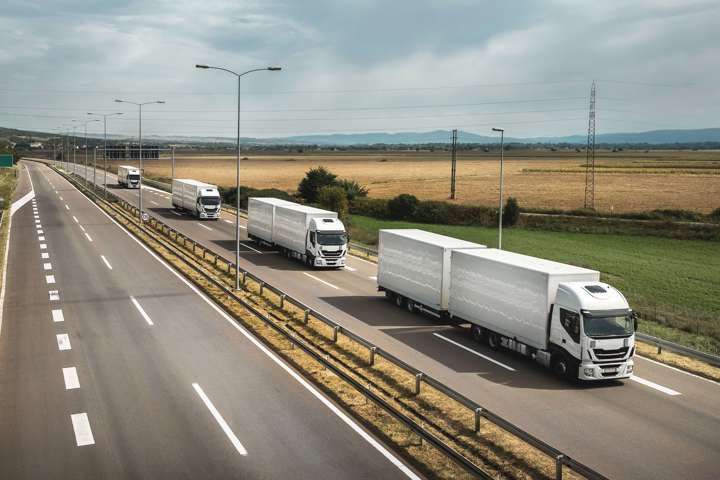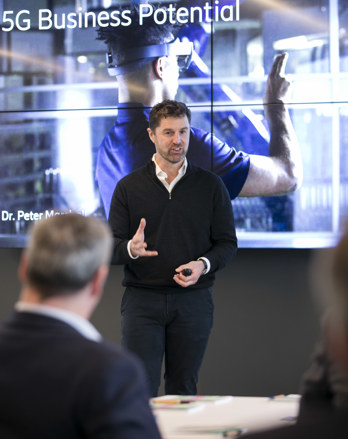
5G takes technological development to a completely new level
28 May 2020
As a platform for innovation and catalyst for development, the recently launched 5G technology entails boundless potential for improving global connectivity across industrial sectors. For instance, SCC patrons Ericsson and Scania have a partnership aimed at shaping the future of connected vehicles. Peter Marshall, Portfolio Marketing Managerat Ericsson, discloses how different industries can benefit from the 5G network’s groundbreaking potential, whilst Peter Vincent, Head of Connected Systems at Scania, unfolds the innovative technology’s role in transforming the autonomous vehicle industry and beyond.
Ever since the introduction of the first digitalnetwork 2G in the 1990s, the telecommunications industry has been an object of incremental change. “Things do not stop in telecommunication – ideas are constantly evolving and being challenged,” says Peter Marshall, Portfolio Marketing Manager at Ericsson. Nevertheless, Ericsson emphasises that the 5G network takes technological developmentto a completely different level: “With 5G, there liability, speed and quality of the connectivity is much higher than ever before.” According to Peter Marshall, the potential of 5G can indeed only be facilitated or limited by the imagination of the human mind: “5G will be successful if people have the imagination to make 5G successful – it will be a platform for innovation.” From Scanias point of view, a differentiating factor of 5G is its ability to reduce latency and improve the data transfer rate. “I believe that fostering reliable mobile networks is a necessity which 5G will provide for us. Since our main goal is to stay connected, it is naturally beneficial to have a higher bandwidth and reduce latency for the transport solution technology,” says Peter Vincent, Head of Connected Systems at Scania.
Cyber sickness
Upon moving into virtual reality experiences, it is vital that the responses of the human senses are accurately synchronised with the expectations of the brain. If the latency exceeds the so-called ‘20 millisecond threshold’, a state emerges called ‘cyber sickness’. “With 5G technology, the latency can be further reduced than the 20 millisecond threshold, thus creating a scenario in which you feel completely immersed in what you are experiencing,” explains Peter Marshall. In recent times, Ericsson has carried out a series of research projects with King’s College London, aimed at reducing the 20 millisecond threshold. For instance, a spectacular use case was undertaken within the realm of music. Connected by 5G technology, Professor Mischa Dohler was playing a piano in Germany, meanwhile his daughter was singing in London. According to professional musicians, the delay must be less than 20 milliseconds in musical collaborations in order to avoid disturbance. “We are showing with 5G that people can collaborate to create musical performances across different countries. This is only possible due to the low latency that 5G introduces into cellular connectivity.”
Network Slicing
Another extraordinary concept entailed by the 5G network is ‘network slicing’, implying that a dedicated subset of the network elements are dedicated for the particular service, maximising the effectiveness of the network and providing the specific capabilities for that service. In specific, a corporation can allocate each business area a specific sensor,which in turn is connected to the 5G platform. To further support this through the introduction of AI and automation, the network can generate predictive algorithms that can aid the understanding of fluctuation in patterns. Moreover, network slicing importantly meets a demand for privatised communication. Safe and efficient communication is particularly important for the internal communication systems of autonomous vehicles. When a vehicle lacks the presence of a human driver, the connected system must take on responsibility for communicating. By collecting data from the vehicle through connectivity, important information about the vehicle’s localisation and potential faults in its system can be reported.“To effectively communicate with autonomous and manual vehicles alike is where Scania sees an urgent need for 5G technology,” says Peter Vincent.
Platooning
In 2016 Scania became the first industrial representative to enter a partnership with Ericsson on the enrolment of 5G technology. “We of course want to stay ahead of the curve by being Ericsson’s first collaborative partner on 5G. In this ongoing collaboration, we can jointly shape the future of transportation systems connected vehicles,” says Peter Vincent. The project focused on the concept of ‘platooning’ – signifying a plurality of trucks being directly connected and continuously communicating, whilst coherently travelling in the same direction. Although there are a variety of levels of platooning – for autonomous and semi-autonomous vehicles alike – the ultimate goal is that the first truck of the trail leads the trucks behind. From Scania’s point of view, it was important to roll out 5G-connected vehicles early enough to stay connected, yet late enough to avoid unnecessary costs. In opposition to consumer technology in which a device can be switched after a few years, the device is placed within the vehicle and is expected to operate exceptionally for at least another ten years to come. “We must have a broad spectrum of technology in our vehicles, wherefore introducing 5G in an early stage is important, so that the devices can stay connected in a decade as well,” says Peter Vincent.
Sustainable transport solutions
In the main, Scania works towards a vision of providing sustainable transport solutions in alignment with its 2025 strategy. The technological shift for the vision is built on three pillars – autonomous, connected and electrified vehicles – which are combined in order tocreate sustainable transport solutions. “Scania develops its solutions by combining efficiencyand sustainability. Connectivity is essential for deducing how to most effectively and sustainably develop transport solutions,” says Peter Vincent. Gathering and analysing data from the performance of individual vehicles as well as introducing feedback loops to drivers, enablesthe optimisation of fuel efficiency. “Connected vehicles reduce the fuel need and fuel costs, whilst putting less demand on our environment,” says Peter Vincent. Scania is particularly mindful about its energy consumption, since the corporation foresees an upcoming scarcity of the resource: “Regardless if you are using a combustion engine running on diesel, bio diesel or an electric driveline, you will still need to use as little energy as possible. In the future world, energy will be one of the most limiting and costly factors.”
Wireless factories
Moreover, 5G technology is an essential factor behind improving the efficiency within the manufacturing industry. Essentially, wireless technology can be used to improve productivity, introduce new service applications and refine overall quality of manufactured goods. Due to force majeure or a sudden external crisis, factories can urgently be obliged to modify production patterns. A current example is the quickly rising demand for hand sanitiser, in wake of the COVID-19 situation. “Wireless factories are capable of delivering goods quickly in order to meet an unexpected customer demand,” says Peter Marshall. Since 5G aids modular factories in adapting to specific projects, unnecessary outage times in terms of restructuring connections can be avoided. Peter Marshall continues: “From an innovation point of view, this is where 5G stands out. 5G has now created a platform for people to work together and create multitudes of co-creation ecosystems.”
For instance, Ericsson has recently engaged in a collaborative project with the German electric car company eGO, aimed at creating a ‘factory of the future’. The electric cars are manufactured by using 5G technology, thus facilitating on-demand delivery of components and an application of augmented reality, which enforces comprehension of the cars’ construction. “This ecosystem has really triggered an entirely new set of innovation. 5G has generated a huge portfolio of solutions that work collectively to benefit the factory. ”Further, the factory ofthe future is described as a production site in which robots constantly communicate, monitoring and surveillance happen remotely and the factory floor is adapted without locking involvement. “In the factory of the future, one will be able to examine, monitor and influence the factory floor externally from all around the world,” says Peter Marshall.

Peter Marshall, Portfolio Marketing Manager at Ericsson.
Photo: Ericsson
Robotic surgeries
Within the healthcare sector, a symbiotic relationship between 5G and robotic technologies can result in substantial valuable impact. Since the outcome of surgeries can be a matter of life and death, quick response rates are of particular importance in robotic surgery experiments. Therefore, the essential latency requirement is below a 10 millisecond threshold, meaning that a robot must respond within a 10 millisecond time frame. In collaboration with the Centre for Robotics Research at the prominent King’s College London, Ericsson discovered how a robot could be manipulated from another room. By utilising three network slices, the project demonstrated how specta- tors could feel what the robot was touching, as well as see and hear everything that was in the same room as the robot. As a result, observers got an identical experience of the sequence of events from a 360 perspective. “Physically we were in one location, whilst our senses, touch, hearing and sight were logically transferred to another location. The most beautiful thing about this demonstration was that digitisation enabled bringing together a plurality of people to observe what the surgeon was doing,” explains Peter Marshall. This transfer of senses has many applications that can support industry and society, such as teaching, emergency services and even tourism.
The future of connectivity
As a result of the evidently demonstrated possibilities of wireless technology, Peter Marshall foresees a rising demand for connectivity in the future. “Both industrial markets, consumer markets and the public sector are showing a strong interest in wireless connectivity, so things are changing quite rapidly.” Likewise, Peter Vincent predicts that autonomous transportation systems must become more effective in the future, which in turn will require a higher degree of connectivity. “The entire logistics solutions and transportation systems will have to communicate more frequently and in detail in the future. Connectivity will be in all parts of the value chain, and we are currently exploring what our role will be in the system.” Similarly, Peter Marshall emphasises that Ericsson also will be a key driver in the future development of connectivity: “I think that Ericsson is in a very strong place, because the appetite for wireless connectivity is constantly increasing, challenging and evolving. Ericsson is a global leader in 5G technology, and I am excited to see what can happen in the future.”
Furthermore, Peter Vincent predicts an increased prevalence of autonomous vehicles in the future, since they are not dependent on drivers to keep them going. “When we get autonomous vehicles running, there will be an increase in the use of the vehicles. Each vehicle will operate 24/7 and consequently wear out faster. That will lead to quicker technology cycles.” Furthermore, he foresees that the requirement of effective technology solutions will increase greatly in the future in correlation with a rising demand for seamless transportation systems. Peter Vincent concludes: “Scania aims to be at the forefront of technological development, by ensuring that we use the right technologies and introduce them in a service-minded way to our customers. Today is the time to change the fundamentals of technology.”

Peter Vincent, Head of Connected Systems at Scania.
Photo: Scania.
BY: SARA APÉRIA
Join our mailing list
and keep up-to-date with the Chamber's news and events.
Read our Privacy Policy here